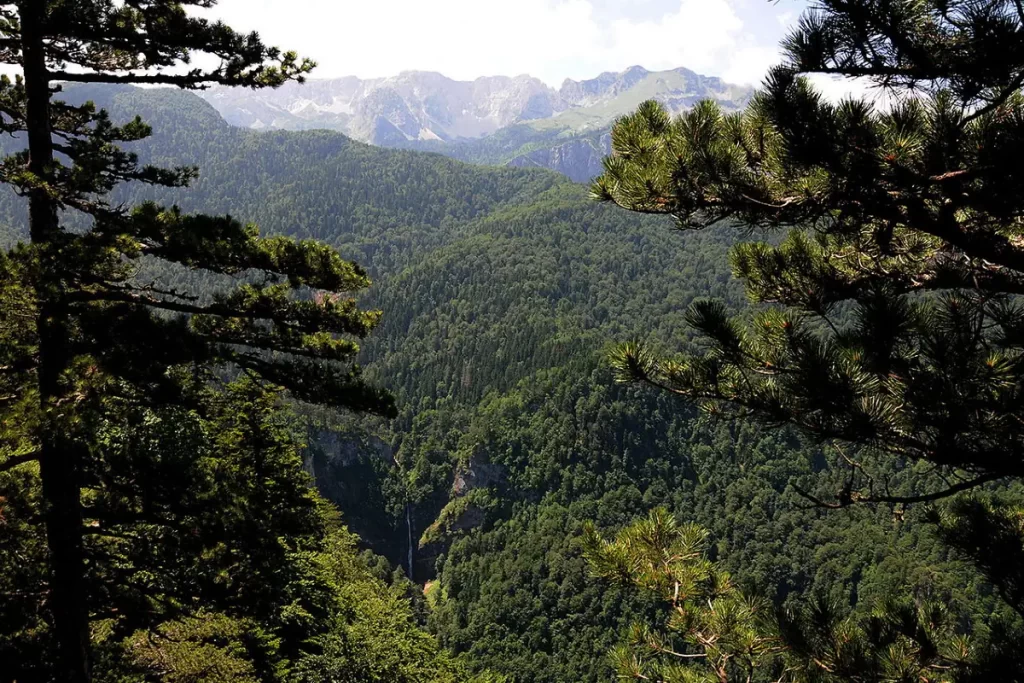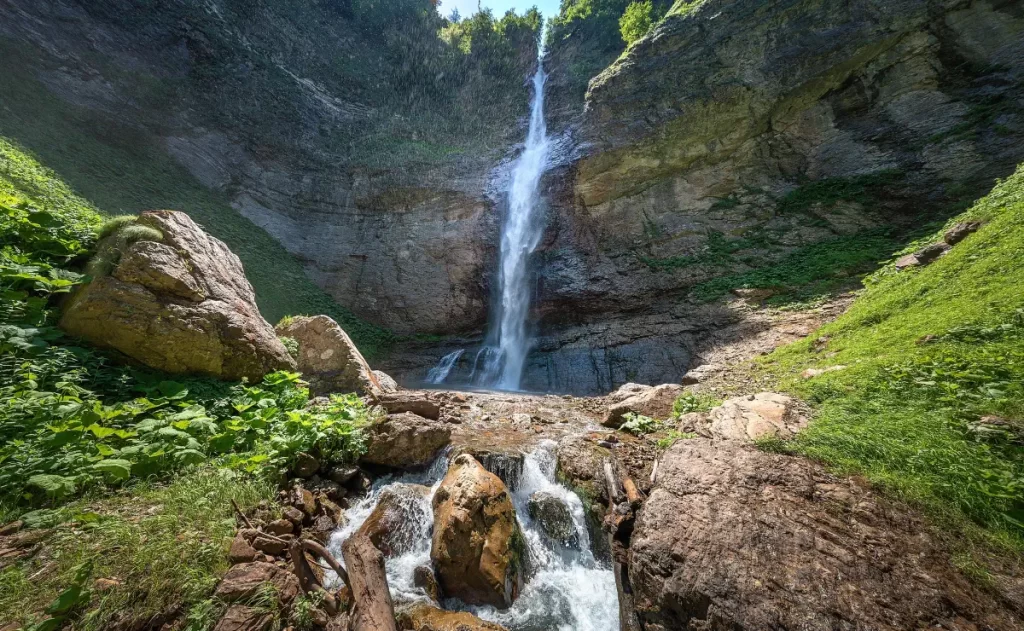Located in Republika Srpska, Bosnia and Herzegovina, Perućica is one of the last two saved primeval forests in Europe (the other being the Białowieża Forest). Perućica has many trees that are 300 years old, and its age is stated to be 20,000 years (it existed even before the last Ice Age which concluded about 11,550 years ago). There are trees over 50 meters high (164 feet) in the forest.

Perućica forest is not fully explored
Perućica forest is part of Sutjeska National Park (established in 1962) in Bosnia and Herzegovina. It is situated beneath the transboundary mountain of Maglić (2,386 meters/7,828 feet, see notes 1), the highest peak in Bosnia and Herzegovina, and separated from Zelengora mountain by the canyon of the Sutjeska River. Maglić
It’s hard to believe there are non-explored regions that still exist in the continent of Europe, but, according to the UNESCO World Heritage website, the Perućica forest is never fully explored.
The forest growth is almost impenetrable in some stretches and according to Wikipedia, it can only be explored in the company of rangers.
What is a primeval forest?
A primeval forest, also known as the old-growth forest or virgin forest is basically a forest that has attained great age without significant disturbance.
The Food and Agriculture Organization of the United Nations defines primary forests as naturally regenerated forests of native tree species where there are no clearly visible indications of human activity and the ecological processes are not significantly disturbed.
Primeval forests are important not only because they preserve rich biodiversity, but also in the perspective of global warming because they are resistant to climate change and constitute the best and most stable carbon reservoirs in the world.
Primeval forests are often home to many rare, threatened, and endangered species of plants and animals.
Perućica primeval forest is a UNESCO-recognized site
Perućica primeval forest is a UNESCO-recognized site because of these criteria:
- Criterion (vii): Skakavac waterfall (see the title “Skakavac Waterfall” below)
- Criterion (ix): Perućica conserves a diverse complex of protected forest ecosystems that exemplify the South-Eastern European mixed forests terrestrial ecoregion. The area has an exceptionally high nature conservation value, including extensive old-growth forests. The large and integral forest area supports complete food webs including viable populations of large mammals and large carnivores. The diversity of plant life in the whole area has contributed to the survival of many animal species. Animal life is very rich and diverse, with a large number of invertebrates, especially butterflies (Lepidoptera), but also amphibians, reptiles, and fish, 36 species and 18 families of mammals, and many species of birds. Important mammals are Bear (Ursus arctos), Chamois (Rupicarpa rupicarpa), Roe deer (Carpelous carpelous), Wild boar (Sus scrofa), Wolf (Canis lupus), Fox (Vulpes vulpes), Badger (Meles meles) amongst other. The richness in dead wood, standing and on the ground, leads to a consequent high diversity of fungi and saproxylic invertebrates (invertebrates that are dependent on dead or decaying wood, or dependent on other organisms that are themselves dependent on dead wood). The long tradition of research on the little disturbed forest ecosystem and the numerous publications, including a description of new species, also contributes significantly to the values of the nominated property.
- Criterion (x): Perućica is an irreplaceable area for biodiversity conservation, due in particular to its size, protection status, and substantially undisturbed nature. The biodiversity conservation values are extensive and flora is diverse and regionally significant. Within the Strict Nature Reserve, among others, in addition to the stands of beech, fir, and spruce, forests of subalpine beech, pure or mixed with Greek maple, Subalpine spruce, and the vegetation of Mountain pine or Mugo pine and mountain grassland vegetation are also protected. There are also rare and endangered wildlife species: wild cat (Felix sylvestris), Lynx (Lynx lynx), Mole rat (Spalax sp.). The list of bird families (in the entire Park) includes nine species of woodpeckers (family-Picidae). This represents 90% of the Picidae family in Europe and this number shows how this forest area and environmental diversity of the park suit them. Woodpeckers depend on old, diseased, and dead trees because it is their food source but also very important for building their nests.
Skakavac Waterfall
At about 75 meters (246 feet) in height, one of the highest waterfalls of Bosnia and Herzegovina, the Skakavac (English: “grasshopper”) is in Perućica forest. It is formed on the mountain creek of Perućica which cuts through the Perućica forest and descends between two steep Maglić slopes.

From the UNESCO World Heritage website:
“Skakavac waterfall makes every human being pleased and happy to be a part of this iconic nature, with such a wealth and diversity of wildlife, preserved intact for present and future generations. At this particular look point a somewhat frightening beauty of the deep, forest-covered valley, almost totally inaccessible suddenly opens at the observer’s feet.”
“In the hearth of this primeval beauty waterfall, Skakavac rumbles crushing down into the precipice, while on the other side of this hill-encircled valley rocky cliffs of Volujak suddenly rise, on the left rises the highest peak of Bosnia and Herzegovina, Maglić and on the right, in the distance across the Sutjeska canyon, the peaks of Zelengora can be seen. An unforgettable view!”
Notes
- Maglić mountain is on the border of Bosnia and Herzegovina and Montenegro.
Sources
- Strict Nature Reserve – Primeval forest “Perućica” on the UNESCO World Heritage Center website
- Perućica on Wikipedia
- Primary forests in Europe, seriously? on the Resilience Blog
- European primary forest database v2.0 on Nature.com
- Skakavac Waterfall (Perućica) on Wikipedia
- Old-growth forest on Wikipedia
- Maglić mountain on Wikipedia
- How Many Elephants are Left in the World in 2025? - August 17, 2025
- Moon Landings: All-Time List [1966-2025] - February 2, 2025
- What Is Max-Q and Why Is It Important During Rocket Launches? - January 16, 2025
